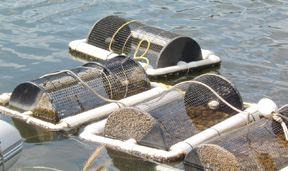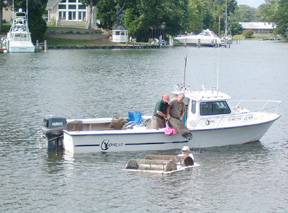
Volume XVII, Issue 39 # September 24 - September 30, 2009 |
 |
 Oysters Are Winning New Friends
Oysters Are Winning New Friends
And influencing more people every day
by Sandra Olivetti Martin
You’d have thought the Southern Maryland Oyster Cultivation Society was serving oyster shooters, given the steady flow of traffic off the beaten path at Annmarie Garden’s Artfest Sept. 19 and 20. You’d have been wrong. Instead, members were urging visitors to spend up to $500 on a SMOCS BOCS (bouyant oyster cultivation system) in which to raise oysters they couldn’t even eat.
Their visitors were listening.
“I was drawn in because I heard about how oysters can clean so much water in a day,” said Sarah Toth of Silver Spring. She didn’t have to go far to see the truth of that hearsay.
Society teen Katie Holmes had filled a pair of display aquariums with water from St. John’s Creek, which borders Annmarie Garden and is visible through the trees. Both aquaria were filled at 11am. In one, oysters were at work. By early afternoon, its water was much clearer than the water in the aquarium with no oysters.
|
|
![]() That’s the vision the 70-some members of the Southern Maryland Oyster Cultivation Society have already invested in.
That’s the vision the 70-some members of the Southern Maryland Oyster Cultivation Society have already invested in.
“It’s a dream of mine for oysters to come back in this creek,” reported Mark Holmes, who lives on St. John’s Creek not more than 500 feet away from where he made his pitch.
“We get enough spat running around the headwaters in this creek, and nature will do the rest. We’re moving toward critical mass.”
A couple of years ago, only fanatics said such things. Now we’re getting to the stage where an oyster cage, float or SMOCS BOCS is a common site on piers.
From step by slow step, native oyster restoration is now proceeding leap by leap.
What happened?
A lot of the explanation is perseverance. Fanatics like Capt. Bob Jensen persevered despite what the skeptics said about their crazy schemes. Capt. Bob’s was an aquatic habitat of three circular oyster reefs created by dropping pieces of an old concrete pier from the Norfolk Naval Station into the James River.
Today, that doesn’t sound any odder than Capt. Bob’s theory, which is the new theorem of native oyster restoration: Oysters will grow if you provide habitat off the bottom, secure from most predators, resistant to storms and out of the chocking muck.
That’s what the Chesapeake Bay Foundation has been advocating for over a decade, recruiting oyster growers and teaching them to make Taylor floats to suspend their crop in the water column.
Now, the idea is spreading by big multiples. This year the state’s Marylanders Grow Oysters program is working with grassroots organizations along 11 Bay tributaries on both shores, rivers and creeks to raise four million oysters.
The Southern Maryland Oyster Cultivation Society is part of that effort — and pushing its envelope of success.
“We’re turning it around,” says Society president Len Zuza, Holmes’ neighbor on St. John’s Creek. “We’re past the theoretics. We’re fine-tuning the solution.”
The Society’s fine-tuning has three parts.
First is better, albeit more expensive, floats.
“The man’s a genius,” says Holmes of Jon ‘Johnny Oysterseed’ Farrington, Holmes’ fellow member and inventor of the labor-saving device that makes oyster cultivation easy. Called a SMOCS BOCS within the Society, it’s a metal mesh drum attached to floats. A gate on the drum opens for cultivators to put oysters in and take them out. Otherwise, the SMOCS BOCS takes care of itself. Rising and falling with the tide twice a day, the SMOCS BOCS spins and the oysters get washed. Thus, there’s no need for cultivators to pull up the heavy float to clean sediment off the growing oysters.
What’s more, Holmes says, the cost disappears because “the state gives every dime back. Fill out form 502 for the credit.”
Second, Southern Maryland Oyster Cultivation Society is focused on achieving critical mass creek by local creek.
“Our notion is to plant oysters near where they were grown. People get involved when it’s close to home,” says Society organizer Matt Regan of the test sites, so called because oysters may, or may not, prosper there.
To make the reefs, Society members collected empty oyster shell from restaurants, then laid shell strata in water four or five feet deep.
The test sites are at St. John’s Creek; nearby Mill Creek; in Solomons Harbor, where 15 members live in the Solomons Landing and Oyster Bay condominiums; and across Solomons Island at Hungerford Creek.
Last month, the Society harvested its first crop of 200,000 oysters. A small flotilla — from Zodiacs to a historic boat lent by Calvert Marine Museum — hauled floats full of half-dollar-size oysters grown from tiny spat over the past year to the new reefs where the growing oysters get down to the serious work of growth and reproduction. The oysters are for the water, not for harvest.
Again the SMOCS BOCS proved its superiority.
“You simply rotate it, give it a shake, and oysters fall out,” Holmes explained.
Third, Southern Maryland Oyster Cultivation Society is a society. Community and commitment are what that word implies, and that’s what they’re about.
As Regan says, “This is not a short-term solution. “We need people who are committed.”
Last week, the state’s Marylanders Grow Oysters program delivered one-third million new seed oysters, and most of last year’s growers are preparing new crops. Regan’s adding two new SMOCS BOCS to his mixed collection of oyster floats, for a total of 10. Each holds 5,000 seed oysters. Thus, some 50,000 oysters will soon be growing off his pier on the Patuxent River.
But 300,000 is a lot of oysters. And restoration is a big goal.
So the Southern Maryland Oyster Cultivation Society is recruiting.
Individuals are fine, but the Society really wants communities.
“We’re trying to promote community investment,” says Zuza. “Get a group interested, and we’ll be glad to work with you and Maryland Department of Natural Resources to set up a community organization to raise oysters.”
Not only that, Zuza adds, but also “put them nearby where you raised them,” a year later, to grow into their own community: a reef that thrives with allied life forms while the oysters grow by filtering the surrounding water.
“People are tired of sitting around,” says Regan. They want to know what they can do.”
Here’s something you can do: www.CMOCS.org.
